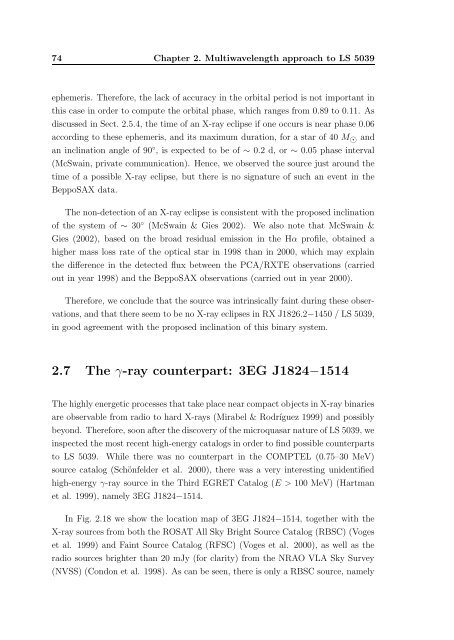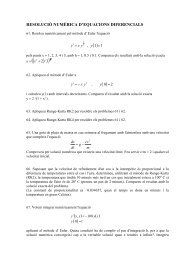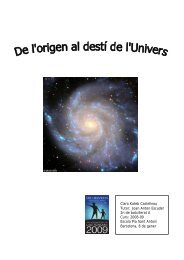Universitat de - Departament d'Astronomia i Meteorologia ...
Universitat de - Departament d'Astronomia i Meteorologia ...
Universitat de - Departament d'Astronomia i Meteorologia ...
You also want an ePaper? Increase the reach of your titles
YUMPU automatically turns print PDFs into web optimized ePapers that Google loves.
74 Chapter 2. Multiwavelength approach to LS 5039<br />
ephemeris. Therefore, the lack of accuracy in the orbital period is not important in<br />
this case in or<strong>de</strong>r to compute the orbital phase, which ranges from 0.89 to 0.11. As<br />
discussed in Sect. 2.5.4, the time of an X-ray eclipse if one occurs is near phase 0.06<br />
according to these ephemeris, and its maximum duration, for a star of 40 M⊙ and<br />
an inclination angle of 90 ◦ , is expected to be of ∼ 0.2 d, or ∼ 0.05 phase interval<br />
(McSwain, private communication). Hence, we observed the source just around the<br />
time of a possible X-ray eclipse, but there is no signature of such an event in the<br />
BeppoSAX data.<br />
The non-<strong>de</strong>tection of an X-ray eclipse is consistent with the proposed inclination<br />
of the system of ∼ 30 ◦ (McSwain & Gies 2002). We also note that McSwain &<br />
Gies (2002), based on the broad residual emission in the Hα profile, obtained a<br />
higher mass loss rate of the optical star in 1998 than in 2000, which may explain<br />
the difference in the <strong>de</strong>tected flux between the PCA/RXTE observations (carried<br />
out in year 1998) and the BeppoSAX observations (carried out in year 2000).<br />
Therefore, we conclu<strong>de</strong> that the source was intrinsically faint during these obser-<br />
vations, and that there seem to be no X-ray eclipses in RX J1826.2−1450 / LS 5039,<br />
in good agreement with the proposed inclination of this binary system.<br />
2.7 The γ-ray counterpart: 3EG J1824−1514<br />
The highly energetic processes that take place near compact objects in X-ray binaries<br />
are observable from radio to hard X-rays (Mirabel & Rodríguez 1999) and possibly<br />
beyond. Therefore, soon after the discovery of the microquasar nature of LS 5039, we<br />
inspected the most recent high-energy catalogs in or<strong>de</strong>r to find possible counterparts<br />
to LS 5039. While there was no counterpart in the COMPTEL (0.75–30 MeV)<br />
source catalog (Schönfel<strong>de</strong>r et al. 2000), there was a very interesting uni<strong>de</strong>ntified<br />
high-energy γ-ray source in the Third EGRET Catalog (E > 100 MeV) (Hartman<br />
et al. 1999), namely 3EG J1824−1514.<br />
In Fig. 2.18 we show the location map of 3EG J1824−1514, together with the<br />
X-ray sources from both the ROSAT All Sky Bright Source Catalog (RBSC) (Voges<br />
et al. 1999) and Faint Source Catalog (RFSC) (Voges et al. 2000), as well as the<br />
radio sources brighter than 20 mJy (for clarity) from the NRAO VLA Sky Survey<br />
(NVSS) (Condon et al. 1998). As can be seen, there is only a RBSC source, namely






